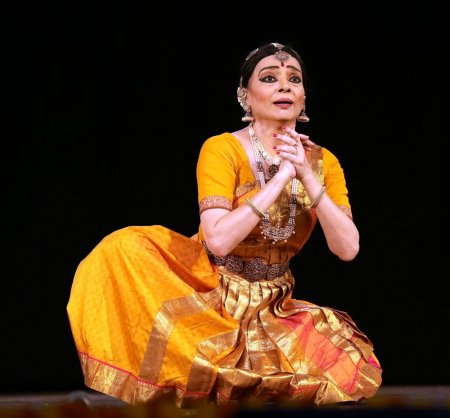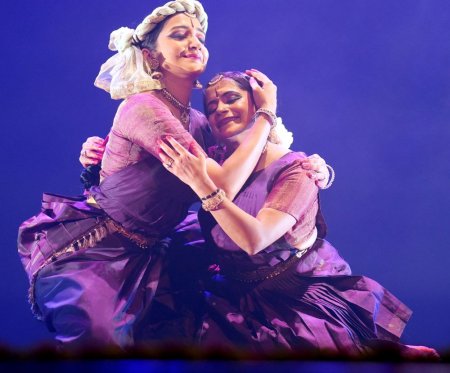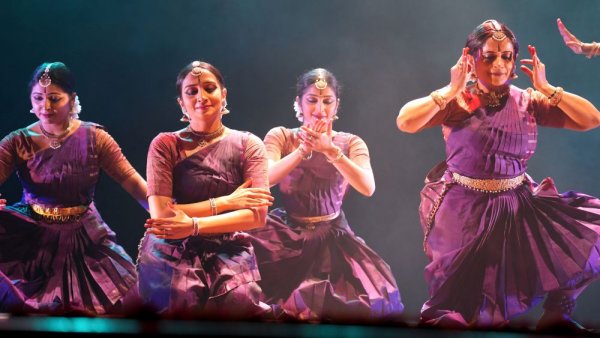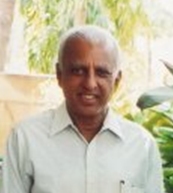
|   |

|   |
Nrityakatha - Satish Suri e-mail: satishism@yahoo.co.in Photos: Prof K.S. Krishnamurthy March 22, 2025 Curated by the Udupa Foundation, 'Nrityakatha' on the 22nd of February at the J.S.S. Auditorium showcased Bharatanatyam's artistry through two distinct performances. The evening began with 'Darshan', a solo presentation by Malavika Sarukkai, whose mastery of the art form is widely celebrated. Known for her impeccable technique, poetic abhinaya, and ability to transcend the physical to evoke the spiritual, Malavika's performance undoubtedly left the audience spellbound. Her nuanced portrayal of emotions and her command over rhythm and movement have been a testament to her decades of dedication to Bharatanatyam. DARSHAN 'Darshan' was a profound exploration of stories and themes that transcend the ordinary, delving into the metaphysical and spiritual realms. The performance began with 'Nrithyanjali', an opening piece that set the tone for the evening, paying homage to the divine and invoking the cosmic energy of the Lord of Dance. The piece opened with verses extolling Shiva, Nataraja, the embodiment of rhythm, energy, and the cyclical nature of the universe. Through her abhinaya and nritta, Malavika brought to life the grandeur of Shiva's cosmic dance, symbolising creation, preservation, and dissolution. The verses highlighted Shiva's vastness - his role as the source of all energy and the ultimate vision of infinity. This invocation set a spiritual tone and established the thematic foundation for the performance, connecting the earthly to the divine. The choreography for 'Nrithyanjali' was set to compositions by A.S. Murali and Bhagyalakshmi, with the ragas Amrithavarshini and Keeravani providing the melodic framework. The rendition of the iconic composition "Krishna nee begane baro" stood out as a highlight of this segment. This Kannada devotional piece, often attributed to Vyasatirtha or Purandaradasa, was a heartfelt call to Krishna, urging him to come quickly. The narrative unfolded with Yashoda, Krishna's foster mother, searching for her mischievous child. The haunting melody of the flute, symbolising Krishna's divine presence, added a layer of mysticism to the scene. The choreography depicted Yashoda's search for Krishna with a sense of urgency and maternal love. When she finally finds him, the moment is both tender and humorous - Krishna, the divine child, is caught putting mud into his mouth. This seemingly innocent act becomes a moment of profound revelation when Krishna opens his mouth to show Yashoda the entire universe within him. This moment of epiphany, where the mortal mother glimpses the infinite nature of her divine child, was portrayed with a sense of awe and wonder. Krishna quickly returns to being just a child, leaving Yashoda to ponder the mystery of his true nature.  Malavika Sarukkai The concluding composition of Malavika Sarukkai's 'Darshan', based on the Raas Leela from the Srimad Bhagavatham and composed by Seetharama Sarma, was a breathtaking culmination of the performance, celebrating the mystical and divine dance of Krishna and the gopis. This piece explored themes of love, devotion, and the union of the individual soul with the divine. The narrative unfolded on a moonlit night, during Sharad Ritu, the autumn season, when the skies are clear after the rains, and the air is filled with a sense of renewal and enchantment. The magical flute of Krishna resonates through the night, calling the gopis to abandon their worldly duties and surrender to the divine call. This moment captures the essence of devotion - the irresistible pull of the divine that transcends all earthly attachments. The choreography, inspired by 17th and 18th-century Indian miniature paintings, brought a visual richness to the performance. These paintings, known for their intricate details and vibrant storytelling, served as a visual metaphor for the layered narrative of the Raas Leela. The dance moved seamlessly from the personal longing of each gopi to the collective ecstasy of the cosmic dance, and from the earthly realm to the spiritual. Each gopi was depicted as deeply devoted to Krishna, her love symbolizing the soul's yearning for union with the divine. The choreography captured their emotions - longing, joy, and surrender - as they left behind their homes and families to follow Krishna's call. As the gopis gathered in the moonlit forest, the dance transformed into a collective celebration. The circular formation of the Raas, with Krishna at the center, symbolizes the cyclical nature of existence and the unity of all creation in the divine. Krishna's multiplication, appearing to dance with each gopi simultaneously, represents the omnipresence of the divine and the fulfilment of every devotee's longing. The imagery of bees drawn to a lotus was used to depict the gopis' attraction to Krishna. Just as bees are irresistibly drawn to the lotus, the gopis are drawn to Krishna, their hearts filled with divine love. The lotus, a symbol of purity and spiritual awakening, further emphasized the transcendental nature of their devotion. The glory of the sun was invoked as an outpouring of devotion, symbolizing the radiant energy of the divine. Just as the sun illuminates the world, Krishna's presence illuminates the hearts of the gopis, filling them with joy and enlightenment. The most enchanting moment of the Raas Leela was when Krishna multiplies himself to dance with each gopi individually. This miraculous act symbolized the boundless nature of divine love - Krishna's ability to be present for every devotee, fulfilling their deepest desires. It also reflected the idea that the divine was not limited by time or space but existed in infinite forms to guide and bless all who seek him. Malavika Sarukkai's portrayal of the Raas Leela was a masterful blend of technical brilliance and emotional depth. Her ability to convey the gopis' longing, Krishna's playfulness, and the spiritual ecstasy of the dance left the audience spellbound. Through her artistry, Malavika brought to life the timeless beauty and profound philosophy of the Srimad Bhagavatham, leaving the audience in awe of the divine dance of Krishna and the gopis. The title 'Darshan' suggests a journey of vision and insight. By beginning with Shiva, the source of all energy, and moving into compositions that evoke both serenity and depth, the performance invited the audience to reflect on the infinite and the eternal. A stellar music ensemble elevated the performance: Dr Murali Parthasarathy (vocals), Nellai Balaji (mridangam), Neela Sukanya (nattuvangam), and T.V. Sukanya (violin). Murugan's lighting design added dramatic depth, while Sandhya Raman's costume and the resonant ghunghroos enhanced the visual and auditory experience. KOHAM- THE SEARCH The second part of the evening featured a thematic presentation titled 'Koham - The Search' by Ambalam Ensemble, led by Indira Kadambi and her disciples. The thematic presentation of 'Koham' (meaning "Who am I?") ties into the broader philosophical inquiry of self-realization and the divine. The dance performance explored the journey of the dancers through three states of existence - Jagrat (waking state): Represented by dynamic, outward-focused movements, symbolizing interaction with the external world. Swapna (dream state): Shown with fluid, introspective movements, capturing the mind's inner world and imagination. Sushupti (deep sleep state): transition from slow movements to stillness, indicating detachment from both external and internal activity, to signify the absence of awareness. Turiya (The fourth): Turiya is that which pervades all three states through seamless transitions or an ethereal quality. The performance began with the Maheshwara Sutras, recited in silence, symbolizing the primordial state before creation. As the causal body disengaged, the five elements - earth, water, fire, air, and ether - were formed, depicted through mime and aerial visuals. The evolution from elements to life forms, culminating in the emergence of homo sapiens, was portrayed through Indira Kadambi's choreography and expressive miming by the artistes. The central question, 'Koham?' was explored through the lens of dance and devotion. Each state of consciousness was rephrased as a dance, reflecting the journey from the physical to the metaphysical. The piece "Adi Shivane kaanave asai kondenadi" (Dandayuthapani Pillai, Adi) introduced Shiva as the goal of the seeker's yearning. The dancer's longing to see Shiva symbolised the soul's quest for the divine, finally leading to contemplate the nature of the self and the divine, culminating in the realization that Shiva is the eternal supreme being, the dance, and the purpose of all action. The dream state (Swapna), explored the emotional and psychological complexities of the human mind through the lens of well-known padams. This section featured Indira Kadambi portraying heroines in three distinct emotional states, each enacted within the realm of dreams. The dream framework allowed for a fluid interplay of reality and illusion, raising profound questions about identity, desire, and the nature of existence. The segment began with the dancers enacting the padam "Choodare," where the heroine condemns another woman for being reckless in her love for Krishna. The dancers' portrayal of this judgmental stance was layered with irony, as the dream framework blurred the lines between the accuser and the accused.  Ambalam ensemble Next, Indira Kadambi portrayed the desolation of the heroine in the padam "Ayyayo vegetayena" in raga Nadanamakriya. Her abhinaya brought depth to the character's longing and heartbreak, capturing the essence of unfulfilled love. The seamless transition from this poignant portrayal to the next scene showcased Indira's versatility as a performer. In a dramatic shift, Indira transformed into Radha from Jayadeva's "Prathama Samagama". The interplay between Krishna's sweet words and Radha's innocence was depicted with subtlety and grace, capturing the divine love play (Leela) between the two. This dream sequence blurred the boundaries between reality and illusion, leaving Indira to wake up with more questions: "Was that a dream? Were these characters real? Were the emotions real? What is real? Is the dream state real or the waking state real? " The segment used the dream state as a metaphor for the fluidity of human emotions and the search for self-identity. By situating the padams within dreams, the performance highlighted how our subconscious mind processes desires, fears, and questions about our place in the world. The heroines' emotional journeys - condemnation, desolation, and seduction - mirrored the complexities of the human psyche, while the dream framework allowed for a deeper exploration of the blurred lines between reality and illusion. The seamless transitions between characters, the evocative abhinaya, and the dream framework created a thought-provoking experience, inviting the audience to reflect on their journeys of self-discovery. The recurring question, "Who am I?" was woven throughout the segment as the dancers grappled with their roles in the dream sequences. Indira's awakening and her questions about the nature of reality and identity underscored the central theme of the performance: the search for the self and the divine. The dream state became a space for introspection, where the boundaries between the self and the other, the real and the imagined, dissolved, leading to a Sushupti - the state of deep sleep, which holds a significant place in the Vedantic exploration of consciousness, and translating this abstract concept into Bharatanatyam was a profound artistic challenge. The portrayal of Sushupti was deeply evocative. The state of deep sleep was characterized by stillness, absence of awareness, and a sense of dissolution where the mind, senses, and ego temporarily cease to operate. Unlike the dynamic engagement of Jagrat (waking) or the fluid, imaginative space of Swapna (dream), Sushupti demanded a unique aesthetic language in dance. The depiction of Sushupti involved suggestive gestures that hinted at the shift from the unconscious void to awakening self-awareness. Such transitions offered powerful moments of artistic impact in exploring consciousness through movement, a deeper understanding of the interconnectedness of all existence.  Ambalam ensemble Turiya, often described as the fourth state of consciousness, transcends the experiences of Jagrat (waking), Swapna (dream), and Sushupti (deep sleep). It is the state of pure awareness, where the individual self dissolves into the universal consciousness - a realm of absolute bliss and non-dual realization. In Vedantic philosophy, Turiya is likened to the silent substratum that exists behind the other states - always present yet often unrecognized. Indira Kadambi's choreography suggested this transcendental state through minimalist movement, evocative silence, and a symbolic visual metaphor. Such moments left a profound impression, inviting the viewer to reflect on the deeper question - "Koham?" - the eternal inquiry into selfhood and blissful awareness. Kadambi's choice to close with 'Soham' aligned seamlessly with the thematic core of self-inquiry, leaving viewers to contemplate the eternal truth: that the seeker, the seeking, and the sought are the same. The synergy between Indira Kadambi's profound vision and the diverse creative inputs from musicians, dancers, and technicians truly elevated the performance. Kadambi's role as the conceptualizer, choreographer, and nattuvangam artiste underscored her multifaceted involvement, ensuring that the philosophical core of 'Koham' was conveyed with authenticity and clarity. The layered musical framework - enriched by T.V. Ramprasadh's soulful vocals, Praveen D Rao's versatile arrangements, and Pramath Kiran's dynamic percussion, the nattuvangam by Praveen Kumar, mridangam by Late Lingaraju, flute by Ravichandra Kulur, Navtar by Vishnu Ramprasad - played a pivotal role in elevating the performance's spiritual and philosophical depth. The combination of diverse instruments - each contributing distinct textures - created a richly layered aural landscape that enhanced the thematic journey of consciousness. The inclusion of evocative voiceovers by Praveen D Rao, Vishnu Ramprasad and Indira Kadambi and a well-crafted script, edited by Pavan Kapnadak, Neharika Patnam, and Ramaa Bharadwaj, showed that the narrative played a crucial role in guiding the audience through the philosophical inquiry. Meanwhile, the dancers - Aishwarya Dileep, Apeksha Kamath, Ramya Suresh, and Saibrinda Ramachandran - beautifully embodied the shifting states of consciousness with grace and precision. Such a richly collaborative effort not only speaks of the technical prowess of each contributor but also highlights the collective dedication to exploring profound themes through artistic expression.  Bangalore based Satish Suri is an avid dance rasika besides being a life member of the Music and Arts Society. |